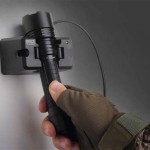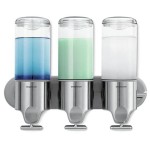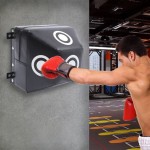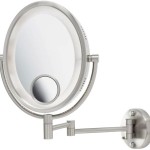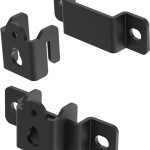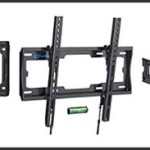Wall Mounted Cookie Sheet Storage: Maximizing Kitchen Space
Kitchen organization often presents significant challenges, particularly in homes with limited square footage. Cookie sheets, baking pans, and cutting boards, due to their size and shape, are notoriously difficult to store efficiently. These items tend to clutter countertops, occupy valuable cabinet space, or create precarious stacks that are prone to toppling. Wall mounted cookie sheet storage offers an effective solution to these common kitchen storage dilemmas. By utilizing vertical space, this type of storage system keeps baking essentials organized, accessible, and out of the way, contributing to a more functional and aesthetically pleasing kitchen environment.
The concept of wall mounted storage is not new, but its application to kitchen organization, specifically for items like cookie sheets, has gained considerable traction in recent years. This is largely due to the growing awareness of space-saving strategies and the increasing availability of diverse and affordable storage solutions. Wall mounted options are particularly advantageous for smaller kitchens, apartments, or homes where maximizing every inch of available space is crucial. They also offer a practical solution for individuals who prefer to keep frequently used items within easy reach, reducing the need to rummage through cluttered cabinets.
The market for wall mounted cookie sheet storage solutions is diverse, offering a range of materials, styles, and installation methods. From simple wire racks to more elaborate wooden or metal constructions, there is a storage option to suit virtually any kitchen décor and budget. The key to selecting the right system lies in carefully considering factors such as the amount of storage space required, the available wall space, the overall aesthetic of the kitchen, and the ease of installation and maintenance.
Key Considerations When Choosing Wall Mounted Cookie Sheet Storage
Selecting the appropriate wall mounted cookie sheet storage system requires careful evaluation of several factors. Prioritization of these considerations will ensure the chosen solution effectively addresses individual needs and seamlessly integrates into the existing kitchen design.
Space Assessment and Capacity: The first step is to accurately assess the available wall space and the number of cookie sheets, baking pans, and other similar items that need to be stored. Measure the height, width, and depth of the intended mounting area to ensure the chosen storage system will fit comfortably without obstructing doorways, windows, or other fixtures. Consider the individual dimensions of the cookie sheets and pans to ensure they will fit within the provided slots or compartments. Furthermore, evaluate the weight capacity of the chosen system, particularly if storing heavier items like cast iron skillets or stoneware baking dishes. Overloading a wall mounted storage unit can compromise its structural integrity and potentially lead to damage or injury. It’s always better to overestimate storage needs rather than underestimate and find the system is inadequate.
Material and Style Compatibility: The material and style of the wall mounted storage system should complement the overall aesthetic of the kitchen. Options range from sleek, modern metal designs to rustic wooden racks and minimalist wire constructions. Metal storage solutions, often made of stainless steel or powder-coated steel, are durable, easy to clean, and resistant to rust and corrosion. They are a popular choice for contemporary kitchens. Wooden racks, on the other hand, offer a warmer, more traditional look and can be stained or painted to match existing cabinetry. Wire racks are a more budget-friendly option and are typically lightweight and easy to install. Irrespective of the material chosen, it is important to ensure it is of high quality and resistant to warping, cracking, or other forms of damage. Furthermore, consider the overall design of the storage system and how it will integrate with the existing kitchen décor. A cohesive design will contribute to a more visually appealing and organized kitchen space.
Installation Method and Stability: The installation method is a critical factor to consider, especially for individuals who are not experienced with DIY projects. Some wall mounted storage systems require professional installation, while others can be easily installed with basic tools and hardware. Before purchasing a system, carefully review the installation instructions and assess personal skills and comfort level. Ensure the necessary tools and hardware are included or readily available. It is also crucial to understand the type of wall to which the storage system will be mounted. Drywall, plaster, and concrete walls require different types of anchors and fasteners. Using the wrong type of hardware can compromise the stability of the storage system and potentially lead to it falling off the wall. For heavier items, it is advisable to mount the storage system directly to wall studs for maximum stability. If mounting to drywall, use heavy-duty drywall anchors that are specifically designed to support the weight of the storage system and its contents. Periodically check the stability of the mounted system and tighten any loose screws or fasteners as needed.
Types of Wall Mounted Cookie Sheet Storage
The market offers a variety of wall mounted cookie sheet storage options, each with its own unique features, advantages, and disadvantages. Understanding the different types of systems available will facilitate a more informed decision-making process.
Wire Racks: Wire racks are a simple and affordable storage solution. They typically consist of a series of wire slots or compartments that are designed to hold cookie sheets, baking pans, and cutting boards vertically. Wire racks are lightweight, easy to install, and allow for good air circulation, which can help prevent moisture buildup and keep baking sheets dry. However, they may not be as aesthetically pleasing as other options and may not be suitable for storing heavier items. Wire racks are often available in a variety of sizes and configurations, allowing for customization to fit specific storage needs. Some wire racks also feature adjustable shelves or dividers for added flexibility. Due to their simplicity, they are often easily cleaned with a damp cloth.
Wooden Racks: Wooden racks offer a more aesthetically pleasing and sturdy storage solution. They are typically made of solid wood or engineered wood and can be stained or painted to match existing cabinetry. Wooden racks can be more expensive than wire racks, but they offer a more durable and visually appealing storage option. They can also be designed with more elaborate features, such as adjustable shelves, drawers, or decorative accents. When selecting a wooden rack, it is important to choose a high-quality wood that is resistant to warping or cracking. Ensure the rack is properly sealed or finished to protect it from moisture and stains. Wooden racks require regular cleaning and maintenance to keep them looking their best. They should be wiped down with a damp cloth and mild soap as needed and may require occasional refinishing to maintain their appearance.
Metal Racks: Metal racks, often constructed from stainless steel or powder-coated steel, are a durable and versatile storage solution. They are resistant to rust, corrosion, and other forms of damage, making them a suitable choice for kitchens with high humidity levels. Metal racks are also easy to clean and maintain, and they can be styled to complement a variety of kitchen decors. They are typically more expensive than wire racks but offer a more robust and long-lasting storage option. Metal racks are often available with adjustable shelves, dividers, or other features that allow for customization to fit specific storage needs. Some metal racks also feature magnetic surfaces, which can be used to store knives or other metal utensils. When selecting a metal rack, ensure it is made of high-quality materials and is properly finished to prevent rust and corrosion. Stainless steel is a popular choice for its durability and resistance to stains and odors.
Installation Techniques for Wall Mounted Cookie Sheet Storage
Proper installation is paramount to ensure the safety and functionality of wall mounted cookie sheet storage. The installation process varies depending on the type of storage system and the type of wall to which it will be mounted. Adhering to best practices and utilizing appropriate tools and hardware will ensure a secure and long-lasting installation.
Locating Wall Studs: The most secure way to mount a heavy object to a wall is to attach it directly to wall studs. Wall studs are vertical framing members that provide structural support to the wall. They are typically spaced 16 or 24 inches apart and can be located using a stud finder. A stud finder is an electronic device that detects changes in density behind the wall, indicating the presence of a stud. Alternatively, one can locate studs by tapping lightly on the wall and listening for a solid sound. Once a stud is located, mark its position with a pencil. Use a level to ensure the marks are aligned vertically. It is essential to use a stud finder accurately to avoid drilling unnecessary holes in the wall. If a stud cannot be located in the desired mounting location, consider using heavy-duty drywall anchors.
Using Drywall Anchors: When wall studs are not accessible, drywall anchors provide an alternative method for mounting objects to drywall. Drywall anchors are designed to grip the drywall and distribute the weight of the object over a larger area, preventing it from pulling out of the wall. There are various types of drywall anchors available, each with its own weight capacity and installation method. Toggle bolts are a strong and reliable option for heavier items. They consist of a bolt and a spring-loaded wing that expands behind the drywall, providing a secure hold. Self-drilling drywall anchors are another popular choice. They are easy to install and do not require drilling a pilot hole. However, they typically have a lower weight capacity than toggle bolts. When selecting drywall anchors, it is essential to choose ones that are rated for the weight of the storage system and its contents. Follow the manufacturer's instructions carefully when installing drywall anchors. Over-tightening or under-tightening the anchors can compromise their performance and potentially lead to damage.
Ensuring Proper Leveling: Before tightening any screws or fasteners, it is crucial to ensure the wall mounted storage system is properly leveled. Use a level to check the horizontal and vertical alignment of the system. If the system is not level, it can cause items to slide or topple over, and it can also look visually unappealing. Adjust the position of the storage system until it is perfectly level, and then securely tighten all screws and fasteners. Recheck the leveling after tightening the screws to ensure the system has not shifted during the process. A properly leveled storage system will not only be more functional but will also enhance the overall aesthetic of the kitchen.

Wall Mounted Sheet Bun Pan Rack 28 X 18 21

24 Kitchen Storage Ideas You Need To Try Extra Space

White 2 Pack Extra Tall Steel Baking Pan Organizer Rack For Cabinet Storage Or Kitchen Counter Cookie Sheet With Dividers Muffin

White 2 Pack Extra Tall Steel Baking Pan Organizer Rack For Cabinet Storage Or Kitchen Counter Cookie Sheet With Dividers Muffin

35 Small Kitchen Organizers That Make The Most Of Tight Quarters Reviews By Wirecutter

Easy Solution For Building A Tray Divider Cabinet

Teal Cookbook Holder Spectrum Diversified Ashley Cabinet Wall Mounted Cutting Board Bakeware Cookie Sheet Organizer Baking Accessory Storage Orga Recipe Book Stand

Teal Cookbook Holder Spectrum Diversified Ashley Cabinet Wall Mounted Cutting Board Bakeware Cookie Sheet Organizer Baking Accessory Storage Orga Recipe Book Stand

Pretty And Practical Kitchen Wall Storage Ideas 2025 Checkatrade

How To Display Cutting Boards In A Kitchen Nourish And Nestle

